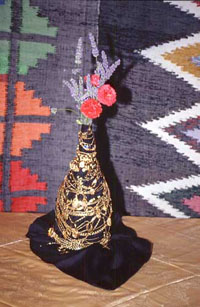|
Wheat has profoundly shaped Sicily’s ancient history. The people who have dominated the island have always been subjected to its natural cycle due to its extensive cultivation. For centuries Sicily, known as the granary of the Mediterranea, had been, with varying economic fortunes, the undisputed leading producer of grain until the Unification of Italy. After that a slow, relentless decline set in.
The harvesting period has represented a working deadline of the utmost importance in Sicily, at least until around the 1970s. Starting from the month of May in the great cereal-growing areas there was the need to recruit seasonal labourers not available in the places of production. Hence, there were seasonal migratory flows of workers from the northern or southern coasts of the island who reached the plains, huge expanses of cereal-growing lands, in the interior of Sicily. The wheat harvest thus became a space and a time for a considerable socialisation and, as a consequence, the chance to re-affirm the values of a life in common, to forge bonds of solidarity, to perform the same tasks, to share vocal expression and ritual customs, outside the confines of the communities of origin. The workers were organised into gangs before leaving their own villages and after a very long walk (18-24 hours for the gangs coming from the provinces of Messina) reached the fields in and around Enna. Once they had arrived it was up to the gang-leader to strike a bargain as to the daily pay for his gang of labourers. This one then moved to the antu (i.e. the field to be harvested), often working side-by-side with gangs coming from other provinces. The long and strenuous working day, which started in the early hours of dawn and ended at dusk (from sunrise to sunset) united the harvesters with the constant repetition of their movements, was marked by time-periods set by the mealtimes (six or seven throughout the day) and the ritualistic enactment of forms of thanksgiving to God and the Saints. It was always up to the cugghituri (the gatherer), usually at the end of the second meal of the morning, to invite the harvesters to intone the prayers of thanksgiving, invoking and praising their own patron saint. Even the pisera (threshing), whose rhythm is set by the circular movement of the animals (mules or oxen yoked in pairs) in the yard stacked up with sheaves of wheat, became configured as a further ritual space of devotion. This procedure was replicated with the same patterns all over Sicily. The cacciante, in other words the man who drove the animals away from the centre of the yard, marked the cacciate, the various moments by which the grain was threshed, while the turnanti (other farmhands) dealt with turning over the grain with their three-pronged forks following the pace set by the animals. With a vocal style that went from being recited as far as to being shouted, the cacciante marked the carrying out of the work with verses of devotion and thanksgiving to God, the Saints and the Madonna, giving the Sacred its central role once again. Alongside these, but with marked rhythmical functions in regard to the pace of work, there was the yelling of incitement to the animals (see Uccello 1964; Sarica-Fugazzotto 1994; Bonanzinga 1995a and b). |
